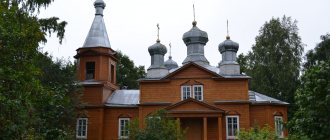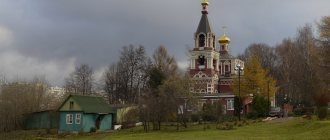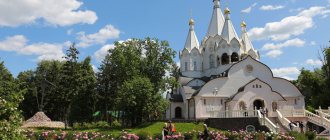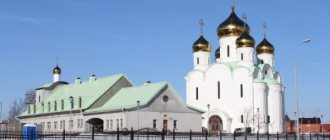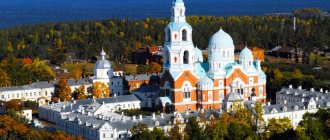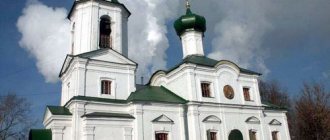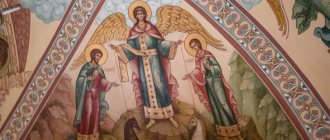Holy Great Martyr Paraskeva
Paraskeva Pyatnitsa is considered the patroness of agricultural workers.
Industrialists, traders and travelers also consider themselves to be under her tutelage and care. In pre-revolutionary Russia there was not a single shopping area where the Church of St. Paraskeva Pyatnitsa did not stand; in Moscow alone there were 4 of them. The name Pyatnitsa was given to her by her parents in memory of the day of the crucifixion of Christ. Paraskeva translated from ancient Greek means “eve of the holiday.” In the Orthodox Church, the day of remembrance of this great martyr falls on October 28. On this day, it is customary to bring fruits to the altar for consecration and store them until the next harvest, thus ensuring its subsequent abundance. They pray to this saint both for the harvest and to prevent the death of livestock. In people, it can heal serious illnesses - both mental and physical. In addition, centuries-old experience contributed to the formation of the tradition of asking girls from the saint for help in a speedy and successful marriage. Therefore, every temple of the Great Martyr Paraskeva Friday is popular. On icons the saint is always depicted with a cross in her hands and a red maforia. She is always strict and stern, and in the paintings associated with the Passion of Christ, she represents Good Friday, the day of Christ's crucifixion. Among the Orthodox, her image is intertwined with Mokosha, a pagan deity, also the patroness of fields and livestock, to whom Friday was also dedicated.
Patronal holidays
There are two altars in the temple. The main one was consecrated in honor of St. Martyr Paraskeva Pyatnitsa, whose memory is celebrated by the Orthodox Church on October 27. The second is in honor of the Nativity of the Virgin Mary, the memory is honored on September 21, as the logical beginning of the new Orthodox year.
Divine service in the Church of the Holy Great Martyr Paraskeva Pyatnitsa
Divine services are held in the temple every day. On weekdays it starts at 8 a.m. in the morning and at 5 p.m. in the evening. On Sundays and the Twelfth Feast, the evening service is also celebrated from 17.00, and there are two liturgies: at 7.00 and 10.00.
The emergence of Butovo
The Temple of Paraskeva Pyatnitsa in Butovo is one of many religious sites dedicated to this great martyr in Moscow. The church has a rich history that began three hundred years before the emergence of the huge Northern Butovo region. Since the 17th century, the concept of “village” has existed in Russia, which is a very small settlement, literally several courtyards in size. But it had to include a chapel. Butovo, owned by clerk Samoilov, was such a village with five households - 3 peasant and 2 bobyl, that is, not having any land plots. It arose on the site of a village of landowners, the Shcherbatovs, who had owned these lands since the 15th century, which burned to the ground.
Chapel, church, temple
There was a wooden church on their estate, which also burned down during the Polish-Lithuanian invasion in 1612. Decades later, namely in 1694, a new stone church was consecrated here, built in the new Russian style according to the design of the architect Blagoveshchensky. The Temple of Paraskeva Pyatnitsa in Butovo was small, and in the 18th century a chapel of the Nativity of the Virgin Mary was added to it. Now there could be up to 400 believers here. In 1903-1904 the temple was renovated. Nearby, in the village of Znamenskoye Sadki, the estate of the Trubetskoy princes, there was also a church, but it has not survived. Together, these two religious buildings were either united into one parish, or separated.
The Paraskeva Pyatnitsa Church in Butovo received its name from a roadside chapel, many of which were named after this saint from ancient times, and she was popular in Rus' even in pre-Mongol times. How could it be otherwise - after all, she patronized the traveler and merchant! Her icon in a glass icon case, a kind of chapel, is now located on the outside of the temple. The church is very beautiful. It, along with the temples dedicated to this saint, erected in ancient Chernigov and Smolensk and preserved to this day, are architectural monuments. The grave of the last rector, Nikolai Bogoyavlensky, is located near the altar, on the east side.
Destroyed churches of Zamoskvorechye. Part II
Continuation. PART I is here
Church of the Intercession in Goliki
. The name “Goliki” is given two interpretations: one – there was a bare, treeless or burnt-out area after a fire, the other – from the name of the homeowner. Historian M.I. Alexandrovsky believed that the Church of the Intercession in Goliki appeared in 1445 as an “ordinary” church, that is, built according to a vow on the day when Vasily II was released from Tatar captivity. Other sources indicate the date of the appearance of the temple as 1625. A stone church with a main altar in the name of the Intercession of the Virgin Mary was erected at the very end of the 17th century with the money of the Labazin merchants. It was one of the last Moscow churches built like a ship.
To the left of the church there were several small areas of the church clergy with houses. Often such houses in Moscow were rented out. The official Nikolai Fedorovich Ostrovsky settled in the house of the deacon of the Church of the Intercession of the Most Holy Theotokos in Goliki, whose son Alexander, the future great Russian playwright, was born on March 31 (old style) 1823. It turns out that the Church of the Intercession is native to Alexander Nikolaevich. The family lived in the deacon’s house for only two years after Ostrovsky’s birth, after which Nikolai Fedorovich, who became a famous lawyer, moved to his own house in Monetchiki near Pyatnitskaya Street.
Alexander Nikolaevich would later write that he remembered the first years of his life thanks to the unique ringing of the bells of the Church of the Intercession in Goliki. Unfortunately, in 1930, neither the church nor the memory of the brilliant writer were spared. The Church of the Intercession was destroyed; they wanted to build a multi-story residential building in its place, but this plan was never realized. The house of the deacon of the Church of the Intercession in Goliki is known to every Muscovite - this is the house-museum of A.N. Ostrovsky on Malaya Ordynka. The church could now stand on the territory of the museum courtyard, and the bell tower of the temple would be located exactly where the bust of Ostrovsky was installed in 1954.
Church of the Kazan Icon of the Mother of God at the Kaluga Gate
. Another church associated with Ostrovsky. With the help of the churches destroyed in Zamoskvorechye, you can study the biography of the playwright. He was born in the parish of the Church of the Intercession in Goliki, then the family moved to Monetchiki, and a few years later to the former Kaluga Gate (here Alexander Nikolaevich lived until he was sixteen years old). Once upon a time there really was a gate to the Zemlyanoy City. Moscow ended here. The first impression that Moscow guests received when entering through the Kaluga Gate was the Church of the Kazan Icon of the Mother of God.
Until 1680, the temple was called Nikolsky. He became Kazan not according to the chapel, but according to a locally revered copy of the miraculous Kazan icon. Only in 1886 did the Kazan chapel appear, when on the site of the ancient church the architect N.V. Nikitin built a new temple - unusual for Zamoskvorechye, majestic, in the Greek style, with a high apse and marble iconostasis. Not only the fate of Ostrovsky, but also of another writer, I.S., is connected with the Church of the Kazan Icon. Shmeleva. His family lived not far from the temple - on Bolshaya Kaluzhskaya Street. Ivan Sergeevich's father, Sergei Ivanovich, was a ktitor of the Kazan Church.
The church more than once appeared on the pages of Shmelev’s works: “Gorkin went to Kazanskaya with other fellows to carry icons.” Or: “There’s our Kazanskaya, the turret is green!” The temple was closed at the end of the 1920s. The building housed the Museum of the Mining Academy, and later the Avangard cinema. And in April 1972, the Church of the Kazan Icon was blown up. The official reason was the arrival of US President R. Nixon in Moscow. Many local residents still remember this explosion. Soon, instead of the church, a five-story “chest” of the Ministry of Internal Affairs appeared. In 1999, a temple-chapel was built next to the ministerial building in memory of the Kazan Church.
Church of Paraskeva Pyatnitsa on Pyatnitskaya
. On the site of the Novokuznetskaya metro station, until the 1930s, there stood the magnificent Paraskeva Pyatnitsa Church - one of the oldest in Zamoskvorechye. It was known since the 16th century and was considered the “simple” or “forgiven church.” There were only three such churches in Moscow: in them a person could receive “forgiveness” - healing from a serious physical and mental illness. In the middle of the 17th century, the first stone temple appeared. Paraskeva Pyatnitsa was the patroness of merchants, so it is not surprising that Zamoskvoretsky merchants participated in the fate of the church on Pyatnitskaya Street.
In the 1740s, with the money of the wealthy merchants Zhuravlevs, who lived in the neighborhood, a temple of the eight-on-four type was built - a striking example of the Baroque era. The main altar was consecrated in honor of the Trinity. A little later, a refectory with Pyatnitsky and Artemyevsky chapels appeared. The author of the project of the bell tower, built in 1748, is the great Moscow architect D.V. Ukhtomsky. The tall, three-tiered, free-standing bell tower served as a gateway to the church territory and was the architectural dominant of Pyatnitskaya Street. Paraskeva's Church was one of the last Moscow churches of the octagon-on-quadrangle type.
In the 1930s, a plan emerged in Moscow to extend the Boulevard Ring to Zamoskvorechye. The area from the Vodootvodny Canal embankment to Pyatnitskaya Street was cleared for the construction of the first Zamoskvoretsky Boulevard. It was then, in 1934, that the Church of Paraskeva Pyatnitsa was destroyed. Fortunately, the Boulevard Ring never appeared in Zamoskvorechye. Only nine years later - in 1943 - the rotunda of the Novokuznetskaya metro station was erected on the site of the church. A wonderful station, by the way, if not for one circumstance... The loss of the Paraskeva Pyatnitsa Church is irreparable for the architecture of Zamoskvorechye and Moscow.
Church of the Righteous Godfather Joachim and Anna on Yakimanka
. Another church, which belonged to the wealthy Kadashevskaya Sloboda, was one of the main monuments of Bolshaya Yakimanka. The Ioakimoanninsky temple was first mentioned in 1493. It is not difficult to guess that Bolshaya Yakimanka Street got its name from the Church of the Godfathers Joachim and Anna. True, the name of the father of the Most Holy Theotokos was unusual for the ears of Muscovites, so it changed and began to be pronounced in the Russian manner - Yakim. Until the end of the 17th century, the church remained wooden. The stone temple was built in the 1680s by wealthy locals.
The new church was a five-domed quadrangle with a main altar in the name of the Annunciation. In 1701, a refectory with side chapels of Joachim and Anna and Sergius of Radonezh appeared. In the second half of the 18th century, a separate bell tower was built, overlooking the red line of Bolshaya Yakimanka Street. In 1866, the church was decorated with a beautiful portal on the western side. Like many other Moscow churches, the Church of Joachim and Anna was closed in the 1930s. However, the temple building was preserved until the 1960s. Inside there was a forge shop for experimental workshops. Factory buildings were added to the church.
The slender bell tower was broken down to the first tier, the temple was beheaded. Some old-time Muscovites still remember how on the night of November 4, 1969, the Ioakimoanninsky Church was blown up to create a passage from Dimitrova Street (in Soviet times, Bolshaya Yakimanka was renamed) to Bolshaya Polyanka. The loss of the church could have been avoided: in its place there is no roadway - only an empty lawn. But the mutilated temple did not fit into the development of the new highway. The Church of Joachim and Anna was a rare seven-domed church for Zamoskvorechye in the 17th–18th centuries and could be one of the main decorations of Zamoskvorechye today.
Church of Cosmas and Damian in Kadashi
. This temple could now decorate Bolshaya Polyanka (before the 1917 revolution it had the address: Bolshaya Polyanka, 4). It belonged to the huge Kadashevskaya Sloboda, which stretched from Bolshoi Tolmachevsky Lane to Kadashevskaya Embankment and from Bolshaya Ordynka to Bolshaya Yakimanka. In the settlement lived weavers who worked for the needs of the Tsar’s court and produced, among other things, embassy tablecloths. On the territory of the settlement there was Khamovny Dvor, a 17th-century manufactory. The Kosmodemyansk Church is one of four suburban churches (unfortunately, only two have survived).
Authoritative historian M.I. Aleksandrovsky claimed that the temple appeared on Polyanka during the time of Ivan the Terrible. The five-domed stone church of Cosmas and Damian on the site of a burnt wooden one was built by Kadashevite Philip Savelyev in 1656. The main altar was consecrated in honor of the Nativity of the Blessed Virgin Mary. In the 17th–18th centuries, Bolshaya Polyanka was called Kosmodamianskaya Street. One of the main decorations of the Temple of Cosmas and Damian in Kadashi was the iconostasis with elaborate wooden carvings and icons in the Moscow Baroque style. In the 18th century, the refectory and its chapels were rebuilt.
In the 1740s, a free-standing high bell tower with an original two-tier walkway on columns was erected. P.V. was baptized in the Kosmodemyansk Church. Nashchokin - a close friend of A.S. Pushkin. The temple was closed in 1930. Three years later, the heads of the temple and the bell tower were demolished. And then the temple was recognized as “not having any special historical and architectural significance.” This is a 17th century church with an unusual five-tier bell tower from the 18th century! In 1939, a six-story residential building was built on the site of the church (Bolshaya Polyanka Street, 4) - one of four large-block houses of the first series built in Moscow.
Church of Peter and Paul on Yakimanka
. Bolshaya Yakimanka Street suffered heavy losses during Soviet times. Almost all of the historical buildings on the right side of the street were lost. Yakimanka lost three of the four churches that were there before the revolution. At the corner with Petropavlovsky (1st Khvostov) lane there was the Church of Peter and Paul on Yakimanka, or in Khvostov. In the 14th century, the village of Khvostovskoye existed on this site, which is mentioned in the will of Grand Duke Dimitri Donskoy. Perhaps a church has stood here since those ancient times. In the 17th century, archers settled on the territory of the former village of Khvostovskoye.
In the early 1650s, at the expense of the archers under the order of Ivan Poltev, a stone church of Peter and Paul was built with the side chapels of St. Nicholas the Wonderworker and Alexy, the man of God. Despite the fact that only a few decades had passed, in 1713, due to the dilapidation of the old church, a decision was made to build a new temple. However, the decree of Peter I banning stone construction stopped the construction of the Peter and Paul Church: it appeared only in the late 1730s. In the middle of the 19th century, architect P.P. Burenin built a new extensive refectory with two side-chapels and a hipped bell tower in pseudo-Russian forms.
In the mid-1920s, the Church of Peter and Paul on Yakimanka was transferred to Baptists for prayer meetings. A few years later, the church was adapted for housing, and in the early 1930s, up to four floors were built. Yes, they built it up, not destroyed it. The building, which was based on the temple, was rebuilt more than once. In the 1960s, it was completely remodeled and transferred to the trade mission of the GDR. Today, in the building on the corner of Bolshaya Yakimanka and 1st Khvostov Lane there are no longer any signs of the Peter and Paul Church, but to this day it remains part of the first floor of this residential building.
Years of hard times
The Church of Paraskeva Pyatnitsa in Butovo suffered all the hardships of the 30s, when churches and their ministers were destroyed. It was closed, desecrated and looted. Then for many years it housed either warehouses or sewing workshops, and later the temple completely burned down. Destroyed, without windows, doors and roof, it began to be restored in the 90s by the efforts of the community to which it was transferred, and in 1998 the temple was consecrated by the Patriarch of Moscow. Believers brought icons, and new ones were ordered from donations. When there was no huge residential microdistrict of Severnoe Butovo, there were several villages in this place - Kiovo, Bitsa, Kachalovo. Therefore, the Church of Friday in Butovo has another name, so to speak, a synonym - the Temple of Paraskeva Friday in Kachalovo.
It is very popular among the local population, but small. Therefore, the construction of a new large religious building, named in honor of the Prophet Elijah, is planned in this area.
Shrines
The ancient temple also has its own shrines, this is, first of all, a reliquary, which contains particles of the relics of the following saints:
- St. Philaret of Moscow;
- St. Maxim the Greek;
- St. Shio Mgvimsky;
- St. blgvv. book David, Konstantin and Theodore of Murom;
- St. right Jonah of Odessa;
- St. Tikhon of Moscow;
- St. Ignatius Brianchaninova;
- St. Mitrofan of Moscow.
This ark contains particles of St. relics of many Russian saints.
New trends
Among the elders of the temple are people who were in the past a sea captain, a military man, and a pediatrician. Perhaps this affects the active church life of the temple. It has a Sunday school, whose students, along with studying religion, take part in sports competitions. The temple provides effective assistance to orphanages and is involved in the rehabilitation of alcoholics and drug addicts.
Among the shrines of the temple there are such rarities as the icon of Equal-to-the-Apostles Nina (Georgian saint), the icon of the Mother of God “Inexhaustible Chalice”, the icon of Seraphim of Swarovsk.
